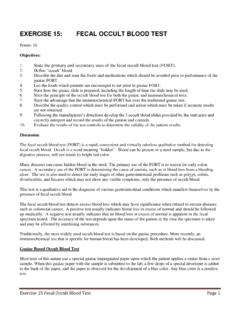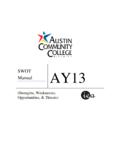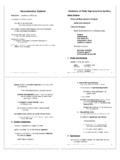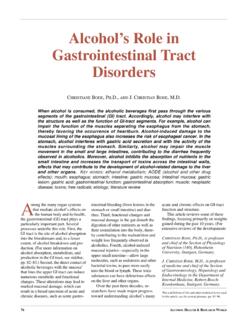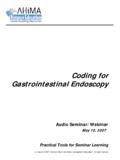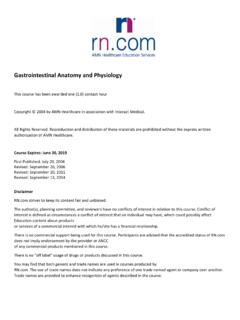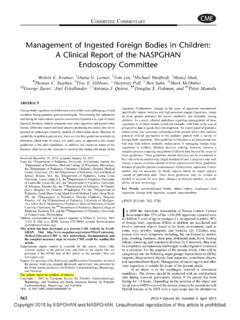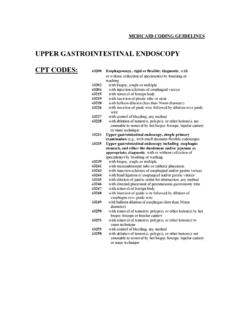Transcription of The Digestive System Anatomy of the Digestive System
1 Human Anatomy & Physiology: Digestive System ; Ziser Lecture Notes, 1 The Digestive System We need food for cellular utilization: !nutrients as building blocks for synthesis !sugars, etc to break down for energy most food that we eat cannot be directly used by the body !too large and complex to be absorbed !chemical composition must be modified to be useable by cells Digestive System functions to altered the chemical and physical composition of food so that it can be absorbed and used by the body; ie Functions of Digestive System : 1. physical and chemical digestion 2. absorption 3. collect & eliminate nonuseable components of food Human Anatomy & Physiology: Digestive System ; Ziser Lecture Notes, 2 Anatomy of the Digestive System organs of Digestive System form essentially a long continuous tube open at both ends !
2 Alimentary canal ( gastrointestinal tract ) mouth!pharynx!esophagus!stomach! small intestine!large intestine attached to this tube are assorted accessory organs and structures that aid in the Digestive processes salivary glands teeth liver gall bladder pancreas mesenteries The GI tract ( Digestive System ) is located mainly in abdominopelvic cavity surrounded by serous membrane = visceral peritoneum this serous membrane is continuous with parietal peritoneum and extends between Digestive organs as mesenteries ! hold organs in place, prevent tangling Human Anatomy & Physiology: Digestive System ; Ziser Lecture Notes, 3 The wall of the alimentary canal consists of 4 layers: outer serosa: visceral peritoneum, mainly fibrous and areolar CT with some pockets of adipose CT muscularis several layers of smooth muscle submucosa blood vessels, lymphatic vessels, nerves, connective tissue inner mucosa: small band of muscle tissue, muscularis mucosa mucus membrane lining contains goblet cells that secrete mucous for protection these layers are modified within various organs !
3 Some have muscle layers well developed ! some with mucous lining modified for secretion of Digestive juices ! some with mucous lining modified for absorption 1. Mouth (Buccal Cavity, Oral Cavity) bordered above by hard and soft palate forms partition between mouth and nasal passages uvula Human Anatomy & Physiology: Digestive System ; Ziser Lecture Notes, 4 is suspended from rear of soft palate blocks nasal passages when swallowing tongue lines ventral border of mouth cavity is skeletal muscle covered with mucous membrane contains taste buds frenulum is thin fold of mucous membrane on ventral surface of tongue that anchors the tongue to the floor of the mouth short frenulum ! tongue tied Teeth two sets deciduous (=baby teeth) (20) begin at 6 months; shed 6-13 yrs permanent teeth (32) each tooth has a crown (above gum) neck is where crown, gum and root meet root (below gum) imbedded in socket gingivitis = inflammation of gum surrounding teeth; can lead to Human Anatomy & Physiology: Digestive System ; Ziser Lecture Notes, 5 periodontal disease kinds of teeth modified for specific functions incisors 4+4; cut, knip canines 2+2; holding onto prey premolars 4+4; cutting, crushing molars 6+6.
4 Chewing, grinding, crushing each tooth is composed of several layers: enamel very hard outer surface on upper exposed crown only resists bacterial attack cannot regenerate if damaged dentin below enamel less hard, similar to bone matrix decays quickly of enamel is penetrated pulp living portion of tooth consists of blood vessels, nerves cementum on root of tooth only outer surface holds root into socket in jaws Human Anatomy & Physiology: Digestive System ; Ziser Lecture Notes, 6 Salivary Glands 3 Pairs of salivary glands: sublingual submandibular parotid largest, below ears mumps = acute infection of parotid gland secrete saliva (enzymes and mucous for digestion) 2. Pharynx (throat) already discussed 3. Esophagus collapsible tube ~ 10 long extends from pharynx to stomach !
5 Gets food through thorax to abdominal cavity posterior to trachea and heart pierces diaphragm uses peristalsis to move food to stomach ! can swallow upsidedown Human Anatomy & Physiology: Digestive System ; Ziser Lecture Notes, 7 drains into stomach through the cardiac orifice surrounded by the lower esophageal sphincter 4. Stomach muscular sac just below diaphragm and liver alimentary canal expands to form stomach 50 mL when empty; up to L after meal Major functions of stomach: 1. physical digestion churning action 2. chemical digestion esp proteins 3. limited absorption (some water, alcohol, certain drugs) divided into 4 regions: cardiac fundus body pyloris cardioesophageal sphincter lesser curvature cardiac fundus pyloric sphincter body greater curvature pyloris Human Anatomy & Physiology: Digestive System ; Ziser Lecture Notes, 8 Muscle layers are very well developed in stomach circular longitudinal oblique Help to break up food by churning action results in milky white liquid = chyme sphincter muscles close both stomach openings: cardioesphageal sphincter (=lower esophageal sphincter) heartburn !
6 Doesn t close properly pyloric sphincter cholic in babies ! doesn t open properly given smooth muscle relaxers mucosal lining of stomach is folded into rugae to allow for expansion with a meal within the mucous lining of stomach are glandular tubes called gastric pits !within gastric pits are numerous microscopic gastric glands: ! secrete mucous for protection ! secretes various Digestive enzymes ! secretes HCl Human Anatomy & Physiology: Digestive System ; Ziser Lecture Notes, 9 5. Small Intestine longest part of alimentary canal: ! 1 diameter x 10 long (living) or 20 long (cadaver) Major functions of small intestine: 1. most chemical digestion of food (duodenum) 2. secretes hormones which direct secretion of Digestive juices by stomach, gall bladder, pancreas 3. most absorption of digested foodstuffs (jejunum & ileum) small intestine fills most of abdominal cavity held in place by mesenteries (=serous membranes) subdivided into 3 functional regions: duodenum ~10 long uppermost drains pyloric stomach receives ducts from gall bladder and pancreas jejunum ~4 Human Anatomy & Physiology: Digestive System .
7 Ziser Lecture Notes, 10 central portion mostly in umbilical region especially rich blood supply most digestion and absorption occurs here absorbs most nutrients, water & salts ileum ~5 mainly in hypogastric region joins to caecum of large intestine absorbs and reclaims bile salts and some additional nutrients mucosal lining of the small intestine is folded into plicae the intestinal mucosa also contains small finger-like projections = villi ~1mm tall each villus contains absorptive epithelial cells and goblet cells core of villus is filled with areolar tissue of lamina propria within this is an arteriole, capillary bed, venule and lymphatic capillary = lacteal 6. Large Intestine diameter x 6 long Human Anatomy & Physiology: Digestive System ; Ziser Lecture Notes, 11 valve-like sphincter separates small from large intestine = ileocecal valve Major functions of large intestine: 1.
8 Absorb additional water as needed by body 2. absorb small amount of additional nutrients some Vit K and B s made by bacteria in lg intestine 3. collects, concentrates and rids body of undigested wastes subdivided into 3 regions: cecum blind ended sac that extends from point of attachment to small intestine contains appendix ! ~ (9cm) long significant source of lymphocytes colon subdivided into: ascending colon transverse colon descending colon sigmoid colon Human Anatomy & Physiology: Digestive System ; Ziser Lecture Notes, 12 on the outer surface of the large intestine are 3 longitudinal bands of muscle tissue = taenia coli ! muscle tone within these bands produces pouches = haustrae that allow distention rectum last 7-8 ends at anus held shut by two anal sphincters: internal anal sphincter of smooth muscle external anal sphincter of skeletal muscle Intestinal Flora our bacterial symbionts exist as a complex interacting community with specific characteristics we re finding that each person has a unique set of microorganisms on their skin and in their guts the abundance of certain bacteria in your feces correlates with your age, gender, body mass index, and nationality our gut bacteria provide many benefits: Human Anatomy & Physiology: Digestive System ; Ziser Lecture Notes, 13 !
9 Help break down hard to digest fibers and starches !make essential vitamins and additional nutrients !protect us from pathogens, toxins and some carcinogens !activate our immune systems to better resist infections gut bacteria change and adapt as your foods change ! those better able to metabolize dominant food tend to increase gut bacteria affect our mood and behavior: correlations have been found between gut flora and some psychiatric disorders such as depression, autism and schizophrenia obesity, diabetes, Crohn s disease, colitis, celiac disease, irritable bowel syndrome all may be the result of an imbalanced microbial ecosystem in our guts some forms of severe malnutrition have been linked to a particulary group of intestinal bacteria promising research has found that fecal transplants have cured symptoms of Parkinsons, diabetes and obesity eg.
10 100% cure rate for C. difficile infections, a deadly disease common in patients on antibiotic therapy Human Anatomy & Physiology: Digestive System ; Ziser Lecture Notes, 14 use of antibiotics can cause dramatic and long term changes in our gut flora and increase risk of some chronic diseases in the future: eg. might be able to test for changes in kinds and numbers of species as an early indication of certain diseases eg. doctors may prescribe bacterial supplements to improve physical health eg. fecal transplants: restores bowel flora to a healthy state 7. Serous Membranes body wall and organs of abdomen are lined with peritoneum !parietal peritoneum !visceral peritoneum most, but not all, of the visceral organs are completely lined with visceral peritoneum these layers are continuous with thin flaps of serous tissues = mesenteries mesenteries allow free movement while holding organs in place and prevent them from tangling greater omentum fold of mesentery extending from stomach and Human Anatomy & Physiology: Digestive System ; Ziser Lecture Notes, 15 duodenum loosely covers the small intestine like an apron contains fat deposits lesser omentum smaller fold of mesentery between liver and stomach Accessory Organs of Digestive tract A.


